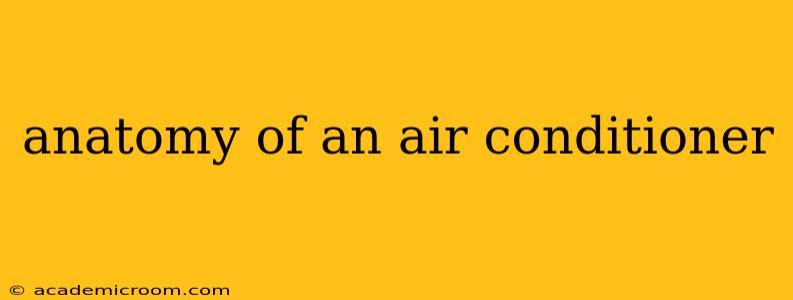Air conditioners, those ubiquitous appliances that keep us cool during sweltering summer months, are surprisingly complex pieces of machinery. Understanding their anatomy helps you appreciate their function, troubleshoot minor issues, and make informed decisions when purchasing or maintaining your unit. This comprehensive guide dives into the essential components of a typical air conditioner, explaining their roles and interactions.
What are the Main Parts of an Air Conditioner?
A standard air conditioner, whether a window unit, split system, or central AC, operates on a fundamental thermodynamic cycle involving refrigerant. Let's break down the key components:
-
Refrigerant: This is the heart of the system. Common refrigerants are designed to absorb heat efficiently at low pressure and release it at high pressure. The type of refrigerant used is crucial for efficiency and environmental impact. Modern units increasingly utilize refrigerants with lower global warming potential.
-
Compressor: This is the powerhouse, a pump that compresses the refrigerant gas, raising its temperature and pressure. The compressor is a significant energy consumer, so its efficiency directly affects the overall energy consumption of the AC unit.
-
Condenser: This component releases the heat absorbed by the refrigerant into the external environment. In most AC units, the condenser is a network of coils where hot, high-pressure refrigerant releases its heat through a process of convection and sometimes, fan-assisted airflow.
-
Expansion Valve (or metering device): This valve regulates the flow of refrigerant, allowing it to transition from a high-pressure, high-temperature state to a low-pressure, low-temperature state. Accurate metering is crucial for efficient cooling.
-
Evaporator: This is where the magic happens – cooling! The low-pressure, low-temperature refrigerant absorbs heat from the indoor air passing over the evaporator coil. This process cools the air, which is then circulated throughout the room or building.
-
Indoor and Outdoor Fan Motors (for split systems): These motors drive fans that circulate air over the evaporator and condenser coils, respectively. Efficient fan motors are essential for maximizing heat transfer.
-
Air Filter (for many units): A filter cleans the air before it passes over the evaporator coil, protecting the system from dust and debris that could reduce efficiency and cause damage.
-
Thermostat: This is the control center, allowing you to set the desired temperature and initiate the cooling cycle. Modern thermostats can integrate with smart home systems for even greater control and efficiency.
How Does Each Part Work Together?
The entire system works in a continuous cycle: The compressor compresses the refrigerant, raising its temperature and pressure. This high-pressure, hot refrigerant then flows to the condenser, releasing its heat. The expansion valve then lowers the pressure of the refrigerant, turning it into a low-temperature, low-pressure liquid. This cold refrigerant flows to the evaporator, where it absorbs heat from the indoor air. The warmed refrigerant then cycles back to the compressor, and the process repeats.
What are the Different Types of Air Conditioners?
There are several types of air conditioners, each with its own design and characteristics:
-
Window Air Conditioners: These units are compact and easy to install, ideal for single rooms.
-
Split System Air Conditioners: These units have a separate indoor and outdoor unit, connected by refrigerant lines. They offer greater flexibility in placement and are more efficient than window units.
-
Central Air Conditioners: These systems are integrated into a building's HVAC system, providing cooling for the entire building. They are more complex and expensive but provide superior comfort and control.
-
Portable Air Conditioners: These units are self-contained and portable, but generally less efficient than window or split systems.
What are Common Air Conditioner Problems?
Common problems include refrigerant leaks, compressor failure, malfunctioning fans, clogged filters, and frozen evaporator coils. Regular maintenance, including filter cleaning and professional inspection, can prevent many issues.
How Can I Improve My Air Conditioner's Efficiency?
Regular maintenance, ensuring proper airflow, and using a programmable thermostat are crucial for maximizing efficiency. Consider upgrading to a more efficient unit as well, especially if yours is older.
This detailed look into the anatomy of an air conditioner provides a foundational understanding of this essential appliance. Remember that regular maintenance is key to ensuring optimal performance and longevity. By understanding each component's role, you're better equipped to address minor issues and make informed choices about your home cooling system.
